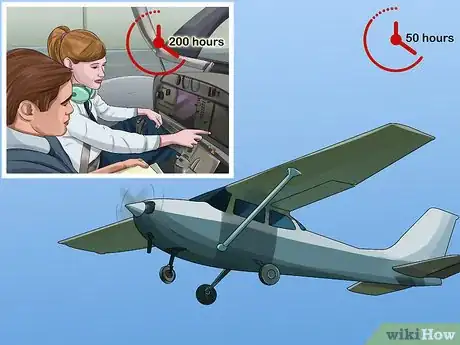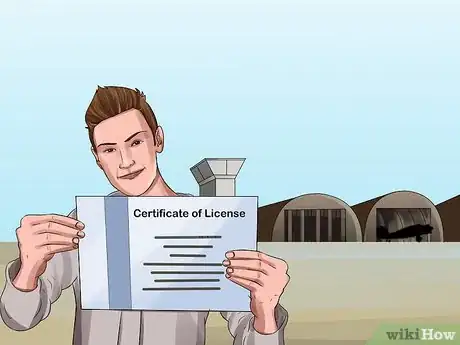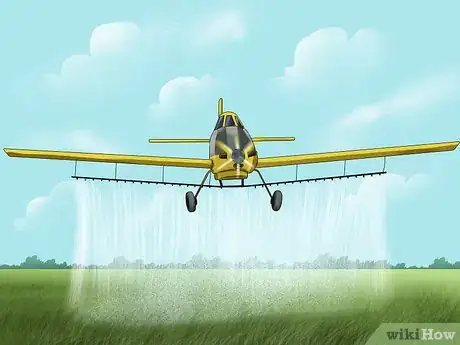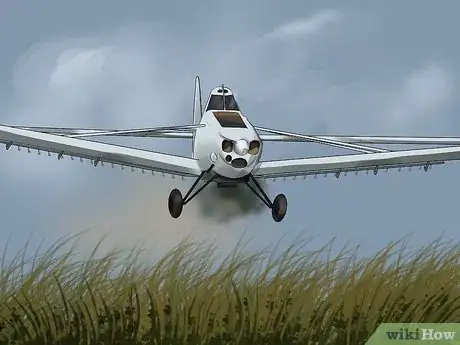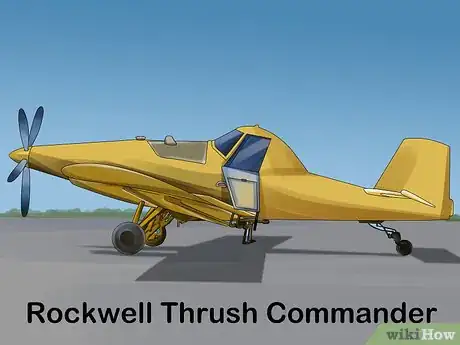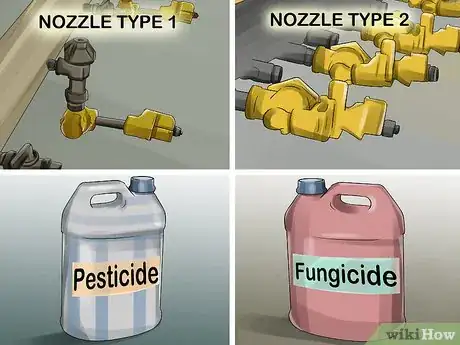This article was co-authored by wikiHow Staff. Our trained team of editors and researchers validate articles for accuracy and comprehensiveness. wikiHow's Content Management Team carefully monitors the work from our editorial staff to ensure that each article is backed by trusted research and meets our high quality standards.
There are 14 references cited in this article, which can be found at the bottom of the page.
This article has been viewed 10,102 times.
Learn more...
Aerial application, more commonly known as “crop dusting,” is one of the most effective means of dispersing fertilizers and pesticides over large areas of cultivated land. To become a crop duster, it will be necessary to obtain a commercial pilot’s licence from your regional aviation authority and complete an intensive flight training program. During this time, you’ll acquire the skills and expertise required to safely deliver large quantities of protection products from a specially-designed agricultural aircraft.
Steps
Receiving the Necessary Training
-
1Apply for your commercial pilot’s license. Before you climb into the cockpit, you’ll first need to be legally certified to operate an agricultural aircraft. This will require you to earn your commercial pilot's license. If you live in the US, you can apply for your commercial pilot’s license by signing up for an official flight training program sponsored by the Federal Aviation Administration.[1]
- In order to be eligible to receive your commercial pilot’s licence, you must be at least 18 years of age, demonstrate fluency in the English language, and submit to a thorough physical and medical screening.
- There may be other requirements in place depending on your specific state, territory, or country.
- Earning your license shows that you’re qualified to operate a small aircraft and are flying in compliance with FAA regulations.
-
2Log 250 hours of flight time. Of your required hours, 200 will be spent learning the ins-and-outs of operating aircraft from an experienced instructor, while most of the remaining 50 will be dedicated to flying under various conditions. You’ll also be expected to perform 10 hours of solo flight time in which you’ll learn to take off, navigate, and land a plane on your own.[2]
- Up to 50 of your 250 hours may be completed in an approved flight-simulator program or similar training module.
- The hands-on portion of your flight training may take weeks or months, depending on how long it takes you to rack up your required flight hours.
Advertisement -
3Take and pass a cumulative practical exam. Upon completing your program, you’ll undergo a practical exam designed to test your expertise as a pilot. This exam covers basic aviation skills such as takeoffs, landings, emergency, instrument calibration, and emergency operations, as well as more technical aerial maneuvers. All skills will be performed under the watchful eye of an FAA Inspector or Designated Pilot Examiner.[3]
- You can find a comprehensive list of the skills and maneuvers covered during the practical exam in the FAA's Airman Certification Standards document.[4]
-
4Complete an agricultural pilot training course. Once you've been awarded your commercial pilot's license, your next step will be to seek out specialized agricultural aviation education. Look for ag pilot programs being offered in your area and enroll in a course that accepts pilots with your individual level of experience. Ag pilot training covers basic farming, chemistry, and entomology principles as well as fundamental aviation skills.[5]
- Courses are carried out both in the classroom and on the airstrip, and may run anywhere from 3-4 weeks to 4-6 months, depending on the amount of previous training you have under your belt.
- In addition to being able to operate different types of aircraft, today’s crop dusters need to be familiar with auxiliary equipment, emergency procedures, and weather patterns that may impact flying conditions.[6]
-
5Search for jobs dusting commercial crops. Update your resume to include your newly-acquired credentials and flying experience and begin sending it out to both commercial and private farms in your area. Some of the best places to inquire about crop dusting positions are big food companies and rural airports surrounded by open farmland.[7]
- You may have to start off as a loader, technician, mechanic before you can graduate to a pilot position.[8]
Performing an Aerial Application
-
1Notify those in the area about scheduled crop dusting activity. In some cases, it’s the responsibility of the pilot to inform residents in a fly-over zone about the presence of potentially-harmful pesticides. Advise these individuals to remain in their homes or take any other safety precautions that may be necessary, such as bringing pets and children indoors or rolling up the windows of their vehicles.[9]
- Stress that the effects of these chemicals are only temporary to help put a worried resident’s mind at ease.
- Your employer will be able to tell you more about whose duty it is to pass along word of a planned aerial application, and what steps are necessary to see that it's done according to FAA regulations.
-
2Line up your approach with your targeted crops. Straighten out the aircraft as you come within a predetermined distance of the crops you’re treating so that you’re flying directly over a single row or set of rows. By getting the plane in the proper position, you can ensure that the chemicals you’re spraying end up exactly where they’re supposed to.[10]
- Flying crooked increases the chances of an incomplete dispersal or spray drift, which can cause chemicals to spread into unintended areas.[11]
-
3Lower the plane to the correct altitude. As you near the targeted crops, push in on the yoke to bring the aircraft down to the predetermined height, then pull back slightly to level it again. The goal is to get as close to the crops as possible while ensuring your own safety and that of any outlying structures. At the moment of release, your plane might only be 10–20 feet (3.0–6.1 m) above the ground.[12]
- Steer clear of trees, fences, power lines, telephone poles, or any other low-lying obstacles that may prevent a successful approach.
- Be extremely careful during the initial descent. Since you’ll be flying so low, there’s little room for error.
-
4Hit the valve switch to disperse the chemicals over the targeted crops. Once you’re in position, release the liquid or powdered protection product from the aircraft’s holding tank. The chemicals will drift over the crops like a mist, covering them in a single, even layer. Each individual application will only last 4-5 seconds.
- Agricultural aircraft are regarded as one of the most efficient means of treating crops due to their ability to coat large patches of cultivated land in a single swoop.
- As an aerial applicator, you’ll fly planes loaded with pesticide, fungicide, and fertilizer at different times.[13]
-
5Return the aircraft to a safe altitude and prepare for the next pass. Pull up and circle around to get into position to dust the next section of crops. Depending on the specific airspace and angle of approach, this may require you to turn the plane 180 degrees and approach from the opposite direction or complete a wider circuit and go back over the targeted area using the same flight path.[14]
Dusting Crops Efficiently
-
1Use an aircraft designed for crop dusting. Aerial application is most often carried out using state-of-the-art agricultural planes. These aircraft are specially-engineered to offer greater control at low altitudes while providing maximum visibility, higher spraying rates, and greater carrying capacity. They also facilitate shorter takeoffs and landings.[15]
- The Rockwell Thrush Commander, Piper PA-36 Pawnee Brave, and M-18 Dromader are a few of the most popular planes among ag pilots.
- These days, crop dusting may also be performed using gliders, helicopters, or even remote-controlled drones. You may need a separate license in order to operate these aircraft legally.
-
2Familiarize yourself with different chemicals and delivery systems. Though it’s referred to as crop "dusting," most applications use liquid pesticides and fungicides because they spread farther and more evenly than those in powdered form. Both liquid and powdered protection products are deployed from the nozzles on a crop dusting aircraft. Some planes are even equipped with variable-rate nozzles and onboard computers to monitor dispersal patterns and minimize spray drift.[16]
- The primary use for powdered chemicals in modern crop dusting is applying sulfur-based pesticides to melons and other large crops.
- Certain chemicals that used to be employed in crop dusting, such as lead arsenate and DDT, have since been banned after being linked to cancer, liver and kidney disease, and other serious illnesses.[17]
-
3Determine the best time to apply chemicals. You’ll typically have the most success in the early morning or late evening, when there’s fewer people out and less air traffic to contend with. It’s also a good idea to keep an eye on the weather around the time that you set out. Strong winds, for example, can interfere with dispersal (as well as the pilot's ability to fly the plane), while rain can wash away chemicals before they can be effective.[18]
- The timing of aerial applications can play a major role in overall yield come harvest time.
- If you work for a large commercial farm or food company, your schedule may be subjected to frequent updates and revisions as weather conditions change.
-
4Use GPS technology to guide your applications. GPS locators make the pilot’s job much easier by making it possible for them to apply chemicals with incredible precision. Many advanced systems are accurate to within 3 feet (0.91 m), which means you won’t have to worry about gaps in coverage or excessive overlap.[19]
- GPS systems can be supplemented with onboard technologies like aerial imaging, infrared mapping of targeted areas, and fully-interactive electronic displays for even greater efficiency.
- Improved accuracy means less waste and safer industry standards for both the pilot and the farming community.
Warnings
- Flying may be exciting, but it’s also extremely dangerous. Never attempt to operate an aircraft without the necessary training and certification, or in conditions that might endanger your safety or that of another person.⧼thumbs_response⧽
- Long-term exposure to pesticides and other chemicals may put you at increased risk of disease.⧼thumbs_response⧽
Things You'll Need
- Aircraft equipped for aerial application
- Pesticide, fungicide, or fertilizer suitable for used on targeted crops
- GPS guidance system
References
- ↑ https://www.faa.gov/pilots/become/
- ↑ http://www.jobmonkey.com/uniquejobs/crop-dusting/
- ↑ http://blog.wayman.net/how-to-qualify-for-a-commercial-pilot-license
- ↑ https://www.faa.gov/training_testing/testing/acs/media/commercial_airplane_acs.pdf
- ↑ http://www.agaviation.org/flightschoolinformation
- ↑ https://www.agexplorer.com/career/aerial-applicator-agricultural-pilot
- ↑ http://www.jobmonkey.com/uniquejobs/crop-dusting/
- ↑ https://www.internationalstudent.com/study-aviation/crop-dusting-pilot/
- ↑ http://www.jobmonkey.com/uniquejobs/crop-dusting/
- ↑ https://www.faa.gov/regulations_policies/handbooks_manuals/aviation/airplane_handbook/media/10_afh_ch8.pdf
- ↑ https://www.scientificamerican.com/article/pesticide-drift/
- ↑ http://www.jobmonkey.com/uniquejobs/crop-dusting/
- ↑ https://www.britannica.com/science/spraying-and-dusting
- ↑ https://www.youtube.com/watch?v=uisV55-4OHs&feature=youtu.be&t=85
- ↑ https://bizfluent.com/info-8130326-types-airplanes-crop-dusting.html
- ↑ http://www.essentialchemicalindustry.org/materials-and-applications/crop-protection-chemicals.html
- ↑ http://www.nj.gov/health/eoh/rtkweb/documents/fs/1098.pdf
- ↑ http://www.jobmonkey.com/uniquejobs/crop-dusting/
- ↑ https://www.internationalstudent.com/study-aviation/crop-dusting-pilot/

